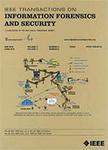版权所有:内蒙古大学图书馆 技术提供:维普资讯• 智图
内蒙古自治区呼和浩特市赛罕区大学西街235号 邮编: 010021

作者机构:Guangxi Univ Sci & Technol Coll Comp Sci & Technol Liuzhou 545006 Peoples R China Jinan Univ Coll Cyber Secur Guangzhou 510632 Peoples R China Guangxi Coll & Univ Key Lab Intelligent Comp & Dis Liuzhou 545006 Peoples R China Jilin Univ Dept Math Changchun 130012 Peoples R China
出 版 物:《IEEE TRANSACTIONS ON INFORMATION FORENSICS AND SECURITY》 (IEEE Trans. Inf. Forensics Secur.)
年 卷 期:2025年第20卷
页 面:1679-1694页
核心收录:
学科分类:0808[工学-电气工程] 08[工学] 0812[工学-计算机科学与技术(可授工学、理学学位)]
基 金:NSFC [12271215, 12326378, 61902149, 62311530098] Joint Funds of the National Natural Science Foundation of China [U24A6013] Guangdong Basic and Applied Basic Research Foundation [2024A1515030089]
主 题:Convergence Security Matching pursuit algorithms Protocols Optimization Data models Computational modeling Servers Resilience Federated learning compressed sensing optimal client selection secure multi-party computation
摘 要:Federated learning faces challenges associated with privacy breaches, client communication efficiency, stragglers effect, and heterogeneity. To address these challenges, this paper reformulates the optimal client selection problem as a sparse optimization task, proposes a secure and efficient optimal client selection method for federated learning, named secure orthogonal matching pursuit federated learning (SecOMPFL). Therein, we first introduce a method to identify correlations in the local model parameters of participating clients, addressing the issue of duplicated client contributions highlighted in recent literature. Next, we establish a secure variant of the OMP algorithm in compressed sensing using secure multiparty computation and propose a novel secure aggregation protocol. This protocol enhances the global model s convergence rate through sparse optimization techniques while maintaining privacy and security. It relies entirely on the local model parameters as inputs, minimizing client communication requirements. We also devise a client sampling strategy without requiring additional communication, resolving the bottleneck encountered by the optimal client selection policy. Finally, we introduce a strict yet inclusive straggler penalty strategy to minimize the impact of stragglers. Theoretical analysis confirms the security and convergence of SecOMPFL, highlighting its resilience to stragglers effect and systematic/statistical heterogeneity with high client communication efficiency. Numerical experiments were conducted to compare the convergence rate and client communication efficiency of SecOMPFL with those of FedAvg, FOLB, and BN2. These experiments used natural and synthetic with statistical heterogeneity datasets, considering varying numbers of clients and client sampling scales. The results demonstrate that SecOMPFL achieves a competitive convergence rate, with communication overhead 39.96% lower than that of FOLB and 28.44% lower than that of BN2. Fu